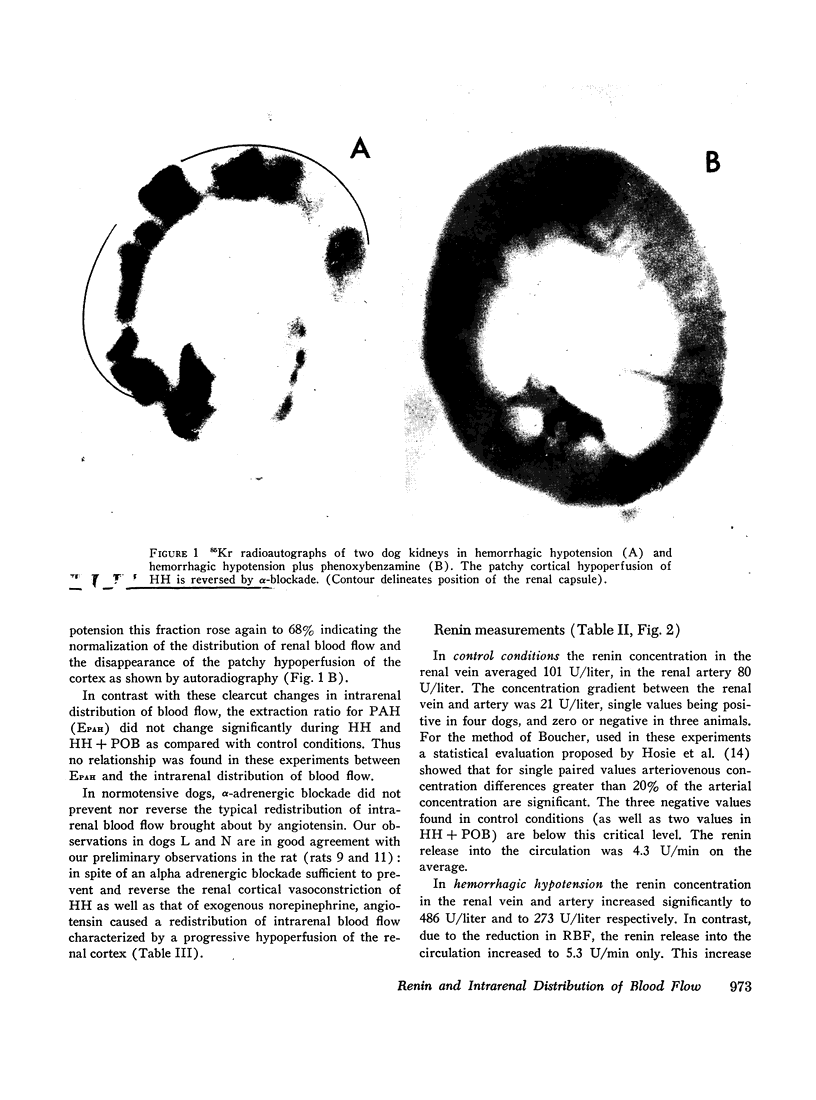Abstract
In order to investigate the possible role of the renin-angiotensin system in the regulation of intrarenal hemodynamics in hemorrhagic hypotension (HH), seven mongrel dogs have been studied under the following conditions: (a) Control, (b) HH (mean arterial pressure 70 mm Hg), and (c) HH + alpha adrenergic blockade by phenoxybenzamine (HH + POB). The following parameters were obtained for the right kidney: Intrarenal distribution of blood flow and local blood flow rates (133Xe washout technique); total renal blood flow (RBF) on the basis of the clearance and extraction ratio of PAH and the arterial hematocrit; plasma renin concentrations in the renal artery and vein by the method of Boucher and his associates; and renin release into the renal circulation.
Alpha adrenergic blockade reverted the typical redistribution of intrarenal blood flow observed under HH. In hemorrhage, arterial and venous renin concentrations increased by a factor of 3.4 and 4.8 respectively. A further small increase was observed during HH + POB with the respective factors increasing to 4.8 and 5.3, as compared with control values. The renin release into the circulation increased by a factor of 1.2 in HH and 4.0 in HH + POB. Whereas in HH there seemed to be a relationship between increased renin concentrations or renin release, and the redistribution of blood flow, no such correlation was found during α-adrenergic blockade. From these observations it is concluded that renin alone is unable to maintain the typical redistribution of RBF seen during hemorrhage. Circumstantial evidence points to a permissive role of the renin-angiotensin system in the pathogenesis of the patchy cortical hypoperfusion caused by sympathoadrenergic mechanisms during hemorrhagic hypotension.
Full text
PDF








Images in this article
Selected References
These references are in PubMed. This may not be the complete list of references from this article.
- BOCK K. D., GROSS F. Renin and angiotensin tachyphylaxis. Circ Res. 1961 Sep;9:1044–1050. doi: 10.1161/01.res.9.5.1044. [DOI] [PubMed] [Google Scholar]
- BOUCHER R., VEYRAT R., DE CHAMPLAIN J., GENEST J. NEW PROCEDURES FOR MEASUREMENT OF HUMAN PLASMA ANGIOTENSIN AND RENIN ACTIVITY LEVELS. Can Med Assoc J. 1964 Jan 25;90:194–201. [PMC free article] [PubMed] [Google Scholar]
- Carrière S., Friborg J. Intrarenal blood flow and PAH extraction during angiotensin infusion. Am J Physiol. 1969 Dec;217(6):1708–1715. doi: 10.1152/ajplegacy.1969.217.6.1708. [DOI] [PubMed] [Google Scholar]
- Ganten D., Hayduk K., Brecht H. M., Boucher R., Genest J. Evidence of renin release or production in splanchnic territory. Nature. 1970 May 9;226(5245):551–552. doi: 10.1038/226551a0. [DOI] [PubMed] [Google Scholar]
- Hodge R. L., Lowe R. D., Vane J. R. The effects of alteration of blood-volume on the concentration of circulating angiotensin in anaesthetized dogs. J Physiol. 1966 Aug;185(3):613–626. doi: 10.1113/jphysiol.1966.sp008005. [DOI] [PMC free article] [PubMed] [Google Scholar]
- Lowe R. F. Effects of adrenergic blockade on the vasoconstrictor action of angiotensin in the perfused hind limb. Proc Soc Exp Biol Med. 1970 Mar;133(3):1060–1065. doi: 10.3181/00379727-133-34625. [DOI] [PubMed] [Google Scholar]
- McGiff J. C., Fasy T. M. The relationship of the renal vascular activity of angiotensin II to the autonomic nervous system. J Clin Invest. 1965 Nov;44(11):1911–1923. doi: 10.1172/JCI105297. [DOI] [PMC free article] [PubMed] [Google Scholar]
- Pals D. T., Fulton R. W. Interrelationship between angiotensin and vascular alpha adrenergic receptors. Am J Physiol. 1968 Mar;214(3):506–512. doi: 10.1152/ajplegacy.1968.214.3.506. [DOI] [PubMed] [Google Scholar]
- Peach M. J., Bumpus F. M., Khairallah P. A. Inhibition of norepinephrine uptake in hearts by angiotensin II and analogs. J Pharmacol Exp Ther. 1969 Jun;167(2):291–299. [PubMed] [Google Scholar]
- Pomeranz B. H., Birtch A. G., Barger A. C. Neural contrfl of intrarenal blood flow. Am J Physiol. 1968 Nov;215(5):1067–1081. doi: 10.1152/ajplegacy.1968.215.5.1067. [DOI] [PubMed] [Google Scholar]
- ROWN J. J., DAVIES D. L., LEVER A. F., PARKER R. A., ROBERTSON J. I. THE ASSAY OF RENIN IN SINGLE GLOMERULI IN THE NORMAL RABBIT AND THE APPEARANCE OF THE JUXTAGLOMERULAR APPARATUS. J Physiol. 1965 Feb;176:418–428. doi: 10.1113/jphysiol.1965.sp007559. [DOI] [PMC free article] [PubMed] [Google Scholar]
- SCHREINER G. E. Determination of inulin by means of resorcinol. Proc Soc Exp Biol Med. 1950 May;74(1):117–120. doi: 10.3181/00379727-74-17827. [DOI] [PubMed] [Google Scholar]
- SCORNIK O. A., PALADINI A. C. ANGIOTENSIN BLOOD LEVELS IN HEMORRHAGIC HYPOTENSION AND OTHER RELATED CONDITIONS. Am J Physiol. 1964 Mar;206:553–556. doi: 10.1152/ajplegacy.1964.206.3.553. [DOI] [PubMed] [Google Scholar]
- THORBURN G. D., KOPALD H. H., HERD J. A., HOLLENBERG M., O'MORCHOE C. C., BARGER A. C. INTRARENAL DISTRIBUTION OF NUTRIENT BLOOD FLOW DETERMINED WITH KRYPTON 85 IN THE UNANESTHETIZED DOG. Circ Res. 1963 Oct;13:290–307. doi: 10.1161/01.res.13.4.290. [DOI] [PubMed] [Google Scholar]
- Truniger B., Rosen S. M., Oken D. E. Renale Hämodynamik und hämorrhagische Hypotension. Klin Wochenschr. 1966 Aug 1;44(15):857–862. doi: 10.1007/BF01711961. [DOI] [PubMed] [Google Scholar]
- Zimmerman B. G., Gisslen J. Pattern of renal vasoconstriction and transmitter release during sympathetic stimulation in presence of angiotensin and cocaine. J Pharmacol Exp Ther. 1968 Oct;163(2):320–329. [PubMed] [Google Scholar]




